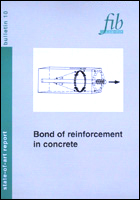Bond of reinforcement in concrete (PDF)
State-of-art report (434 pages, ISBN 978-2-88394-050-5, August 2000) - PDF format
fib Bulletin No. 10
Title: Bond of reinforcement in concrete
Category: State-of-art report
Year: 2000
Pages: 434
Format approx. DIN A4 (210x297 mm), 30 tables, 251 illustrations
ISBN: 978-2-88394-050-5
DOI: doi.org/10.35789/fib.BULL.0010
Abstract: In 1993, the CEB Commission 2 Material and Behavior Modelling established the Task Group 2.5 Bond Models which continued under the same name also after May 1998, when CEB merged with FIP to fib, in order to finalize this state-of-art report based on which a new Task Group intends to develop practical recommendations (Model Code like text proposals).
The work was organised in Working Parties (WP), every party being responsible for one chapter in the state-of- art report:
1 - Bond mechanics including pull-out and splitting failures.
The bond models are presented and compared, because they form the base for a possible new computerised code of practice.
2 - Anchorage and bond in high strength concrete.
Concretes have to day strengths far beyond C80, which is the strongest concrete mentioned in Model Code 90. The bond performance of reinforcement in HSC is more brittle and different from that in NSC.
3 - Bond under repeated loading.
The knowledge of bond under repeated loads is dispersed and had to be brought together to become an efficient source for code of practice development.
4 - Bond of corroded reinforcement.
To be able to judge the durability of bond resistance of reinforcement, which has started to corrode, a condensation of knowledge in this field is important.
5 - Bond of fusion bonded epoxy coated reinforcement.
The knowledge of bond of epoxy coated bars has to be made covering and consistent to be correctly interpreted for use as firm base for codes in practice.
6 - Bond of prestressing tendons.
Developments are going on with thicker and stronger strands used for prestressing. New material has to be gathered for conclusions for an improved code.
7 - Bond of non-metallic reinforcement.
New reinforcing materials for concrete with continuous carbon, aramid and glass fibers, FRP (Fiber Reinforced Polymers), have been developed. Wrapping techniques and external reinforcements have come into use. The bond problems of FRP are treated in order to provide a base for a new code.
8 - Innovative developments in the light of bond philosophy.
Students of today have little knowledge about the earlier developments, because the older information is not always available in computerised information bases. It is important to know how the understanding of bond problems has grown gradually. Possible developments concerning bond are considered.



